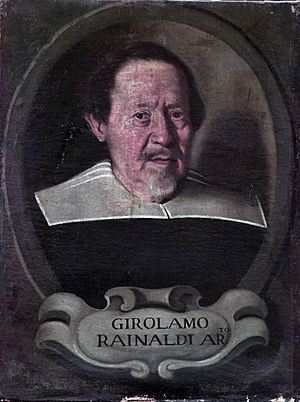Girolamo Rainaldi facts for kids
Quick facts for kids
Girolamo Rainaldi
|
|
|---|---|

A self portrait of Girolamo Rainaldi
|
|
| Born | 4 May 1570, Rome |
| Died | 15 July 1655, Rome |
| Nationality | Italian |
| Known for | Renaissance architecture |
Girolamo Rainaldi (born May 4, 1570 – died July 15, 1655) was a famous Italian architect. He mostly designed buildings in a style called Mannerism. This style was a bit older and more traditional than the new, exciting Baroque style that was becoming popular. Girolamo often worked with other architects on his projects. He was also a rival of the very famous architect Bernini. Girolamo's son, Carlo Rainaldi, later became an even more well-known architect, creating many beautiful Baroque buildings.
Contents
Early Life and Training
Girolamo Rainaldi was born in Rome, Italy. His father was a painter from a town called Norcia. Girolamo learned his skills from a talented architect and engineer named Domenico Fontana. He also worked as a junior partner with Giacomo Della Porta. After Della Porta, Girolamo became the main architect for the Pope in Rome. He was in charge of important projects like the buildings on the Campidoglio hill.
Important Projects in Rome
Girolamo Rainaldi worked on many important buildings in Rome. He helped finish the Palazzo Albertoni Spinola, which Giacomo Della Porta had started. He also worked on smaller things like altars and church decorations. He helped complete parts of St Peter's Basilica.
One of his big jobs was finishing Michelangelo's design for the Campidoglio. He carefully designed the Palazzo Nuovo to look like a mirror image of Michelangelo's Palazzo dei Conservatori. This showed his skill in matching existing grand designs.
Designing for the Pope
Girolamo became the Pope's main architect in 1644. This happened when Cardinal Pamphili became Pope Innocent X. Girolamo was the cardinal's favorite architect, and this made him very important, even more so than Bernini for a while!
He designed the Palazzo Pamphilj in Piazza Navona around 1645-1650. He also started the plans and foundations for the church of Sant'Agnese in the same square in 1652. However, another architect named Francesco Borromini took over the project the next year. After Girolamo died, his son Carlo was asked to finish the church.
Girolamo also designed the front of the Chiesa di Gesù e Maria. This project started in 1642 but wasn't finished until after he passed away. He also designed a building for the Jesuits in the Piazza del Gesù. This building had a traditional Mannerist style, without any of the new Baroque details.
Other Notable Works
Girolamo Rainaldi also designed tombs in the Santa Cecilia in Trastevere church. He helped create the beautiful Baroque gardens at Villa Borghese. In 1641, he was chosen as the head of the Academy of St. Luke, which was a very important art academy in Rome.
Working for the Farnese Family
Girolamo was almost like the personal architect for the powerful Farnese family. In their stronghold of Caprarola, he built the Church of SS Maria e Silvestro between 1621 and 1623. He also designed the rich interior of Santa Maria della Consolazione in Caprarola.
He even helped the Farnese family by adapting two large ancient granite basins into matching fountains for Piazza Farnese in 1626. The Farnese family also took him to Parma to build their city palaces there. He also designed the ceiling of the Santissima Annunziata church in Parma.
Projects Outside Rome
Rainaldi was also busy in Bologna. He designed the ceiling for the huge San Petronio church. He also designed the Church of Santa Lucia in 1623.
For Francesco d'Este, a duke who had lost his main city, Girolamo helped build the Ducal Palace in Modena. He was especially in charge of the gardens, with their fancy water features and a theater made from trimmed hedges, between 1631 and 1634.
Girolamo Rainaldi is buried next to his father in the Church of Santi Luca e Martina. This church was partly designed by Girolamo's father and partly by another famous architect, Pietro da Cortona.
See also
 In Spanish: Girolamo Rainaldi para niños
In Spanish: Girolamo Rainaldi para niños

